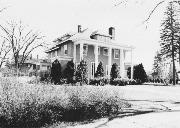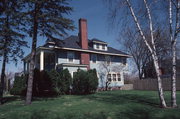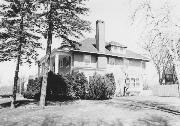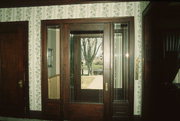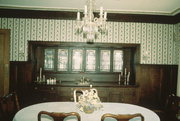Property Record
112 S DAKOTA AVE
Architecture and History Inventory
| Historic Name: | Stella and William F. McNally House |
|---|---|
| Other Name: | |
| Contributing: | Yes |
| Reference Number: | 47172 |
| Location (Address): | 112 S DAKOTA AVE |
|---|---|
| County: | St. Croix |
| City: | New Richmond |
| Township/Village: | |
| Unincorporated Community: | |
| Town: | |
| Range: | |
| Direction: | |
| Section: | |
| Quarter Section: | |
| Quarter/Quarter Section: |
| Year Built: | 1912 |
|---|---|
| Additions: | 1963 |
| Survey Date: | 1983 |
| Historic Use: | house |
| Architectural Style: | American Foursquare |
| Structural System: | |
| Wall Material: | Clapboard |
| Architect: | |
| Other Buildings On Site: | |
| Demolished?: | No |
| Demolished Date: |
| National/State Register Listing Name: | New Richmond West Side Historic District |
|---|---|
| National Register Listing Date: | 5/31/1988 |
| State Register Listing Date: | 1/1/1989 |
| National Register Multiple Property Name: |
| Additional Information: | #650: Garage. This two story residence has clapboard exterior fabric. The hip roof is covered with asphalt shingles. There are five hip roof dormers, one each on the south and east sides, two on the north and a slightly larger three-bay dormer on the west or front of the house. The front entry door is surrounded by transom and side lights. There are four second story 6/1 windows - the outer ones being larger than the two middle ones. The first story windows are also 6/1 on both sides of the entry. The five front porch columns are two stories high and were added in 1963. There are two pilasters near the front corners under the porch. The columns are square with capital detailing and an indented square pattern. Small dentils are under the porch eave as well as on the two one-story flat roof additions in front. These are identical in shape and size. Windows have wood frames. Most are 6/1 and aluminum window inserts have been put in front of them. Window placement on the sides is irregular. A brick fireplace is on the south exterior wall. The north side of the house has two entries. A central one has a narrow roof and round fluted columns with capitals. Small dentils are under the roof here also. This porch has a concrete block foundation. The rest of the house has a rock-faced foundation. The east side has a first story multi-paned picture window as well as second story windows. A second story enclosed porch on the southern part of this facade extends past the house. Non-functioning brackets are on the bottom edge of this. Part of the basement is visible here. There is an entry from the exterior to the basement. Landscaping is simple, consisting mainly of evergreens near the house and a hedge on the north side. There are some large trees on this corner lot; Dutch elm disease destroyed many. A new built-in pool and picket fence are recent rear additions. A one-story garage SE of the house has clapboard exterior fabric and an asphalt shingle hip roof (SC 35/4). There is a small hip roof dormer on the north side, as well as a 6/1 window and a door. The garage doors face an alley on the east. The residence is in excellent condition. The north side porch (with concrete block foundation) and two front one story sections fit in well with the character and appearance of the main building, which is square in plan. The porch was at one time only one story with round columns. The garage, when seen from the west (or front) side has the appearance of a small home or outbuilding and is not immediately obvious as a garage. The building has retained its integrity and fits in nicely with the immediate neighborhood. It is a similar size, although somewhat later in style than the homes adjacent to it. This residence is a good example of American Foursquare styling. The square plan and hip roof with dormers are characteristic of this. It incorporates both Craftsman and Colonial Revival detailing. This is not unusual in a house of this sort, since American Foursquare is basically just a shape to which the owner or builder could add. The porch details are Colonial Revival. The simplicity of design lines (even the Colonial Revival detailing is understated) and irregular window placement are Craftsman characteristics. Windows were designed to be functional from their interior use, not just symmetrical and part of the exterior design. Along these same lines, the square two-story floor plan is another characteristic of this style. Because the porch was altered in 1963 and it was a major change, this residence has no architectural significance as an individual house. However, it still has the same proportions and massing as well as many of the original details. Also, as already noted, it fits in nicely with the character of the neighborhood. In late 1911, William McNally bought this property from Mrs. A.C. Van Meter. Actual posession would be on April 1, 1912. The Van Meter homestead was to be torn down and a new home built. The paper lamented "the destruction of the Van Meter homestead [which] will mark the passing of one of the few remaining landmarks in that part of town." The McNally house cost approximately $10,000 to build. McNally was around 51 years old and his wife Stella was 45 years old at this time. They had five children and were of Irish descent. He moved from West Second Street (probably 350 West Second Street, owned by a family member now). McNally was a lawyer and partner in the New Richmond Rolling Mills. In 1896 and 1897 he was mayor. He died in 1923 and his widow lived here until ca. 1967 when she died at the age of 102. This home is interesting for its association with the McNally family. The family was active in civic, cultural, and business affairs in New Richmond. |
|---|---|
| Bibliographic References: | New Richmond News 1/23/1997. New Richmond Walking Tour brochure, 2000. |
| Wisconsin Architecture and History Inventory, State Historic Preservation Office, Wisconsin Historical Society, Madison, Wisconsin |

